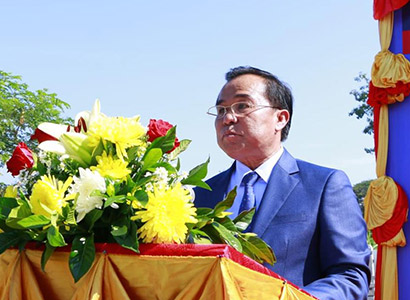Ground broken for Water Resources Management and Agricultural Water Supply Project
The governments of Laos and the Republic of Korea have officially initiated a significant Water Resources Management and Agricultural Water Supply Project using digital information system in Vientiane, marking a pivotal step towards enhancing agricultural productivity in Laos.
A groundbreaking ceremony for the scheme took place on December 10, when officials celebrated the collaboration that aims to integrate modern Korean technology into Laos’ irrigation systems.
 |
 |
| Mr Son Hyeuk Joon. |
Dr Khamphachanh Vongsana. |
The project, which is backed by a grant of over US$5.6 million from the Korean Ministry of Agriculture, Food and Rural Affairs, is set to be built in Pakngum district.
This initiative follows the approval of Laos’ project proposal in September 2022, highlighting a commitment to improving agricultural practices through advanced water management techniques.
Those attending the groundbreaking ceremony included Laos’ Deputy Minister of Agriculture and Forestry Dr Chanthakhone Bualaphanh; Minister-counsellor of the Embassy of the Republic of Korea to Laos, Mr Kim Jong- min; Director of the Global Project Office at the Korea Rural Community Corporation (KRC), Mr Son Hyeuk Joon; and other officials from both sides.
Addressing the groundbreaking event, Director General of the Department of Irrigation, Ministry of Agriculture and Forestry, Dr Khamphachanh Vongsana, said the project aims to develop and modernise the monitoring and water management system along with improving the irrigation system.
Mr Kim Jong-min highlighted the symbolic significance of the project, stating, “This project serves as a landmark in agricultural and rural development cooperation between Korea and Laos, contributing significantly to sustainable agricultural growth and farmers’ income.” He further emphasised, “With the 30th anniversary of diplomatic ties between Korea and Laos approaching next year, the partnership between the two countries will continue to strengthen.”
Mr Son Hyeuk Joon, emphasised the project’s innovative features, stating, “With the introduction of digital water management and solar-powered pumping systems, we aim to reduce operational costs and promote sustainable water resource management.” He added, “The establishment of a Water User Association (WUA) will empower local farmers to manage and maintain the irrigation system, ensuring sustainability and community participation.”
By ensuring a reliable supply of irrigated water across 360 hectares throughout two seasons, the project is set to meet the critical need for efficient irrigation practices across Laos, with agriculture being the primary source of employment for most people.
A notable feature of this initiative is the incorporation of solar energy solutions to power irrigation systems. This move not only seeks to reduce electricity costs but also aligns with Laos’ broader goals of promoting renewable energy sources.
The Director General explained that a pilot site will be created for the use of solar energy in a bid to reduce the debts accumulated due to electricity bill payments owed by the irrigation sector, while boosting farmers’ incomes and sustainable agricultural production.
The main activities of the project include constructing and improving the water pumping system, developing a modern water management system and irrigation management control centre, and installing a solar power system.
“When construction is complete, I believe the project will serve as a model for using new technology from the Republic of Korea to efficiently and effectively manage irrigated water.” Dr Khamphachanh said.
He recalled how the project was initiated when he presented a project proposal at an online roundtable meeting between the Korean Ministry of Agriculture, Food and Rural Affairs and delegations from seven Southeast Asian countries in July 2021.
A feasibility study was conducted in January 2022 before the project was approved by the Korean ministry for funding.
By Advertorial Desk
(Latest Update December 16, 2024)
|




